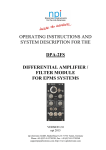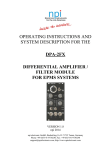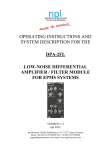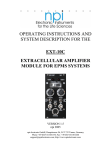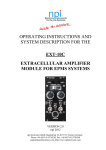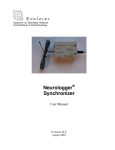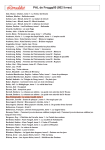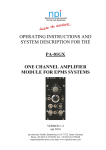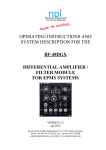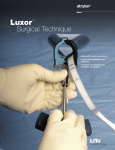Download OPERATING INSTRUCTIONS AND SYSTEM DESCRIPTION FOR
Transcript
OPERATING INSTRUCTIONS AND SYSTEM DESCRIPTION FOR THE EXT-02F EXTRACELLULAR AMPLIFIER WITH FILTERS One or Two Channel Recordings VERSION 4.1 npi 2013 npi electronic GmbH, Bauhofring 16, D-71732 Tamm, Germany Phone +49 (0)7141-9730230; Fax: +49 (0)7141-9730240 [email protected]; http://www.npielectronic.com EXT-02F User Manual ________________________________________________________________________________________________________________ Table of Contents 1. Safety Regulations .............................................................................................................. 3 2. EXT-02F ............................................................................................................................. 4 2.1. Components ................................................................................................................. 4 2.2. System Description...................................................................................................... 4 2.3. Description of the Front Panel..................................................................................... 4 2.4. Description of the Rear Panel...................................................................................... 8 2.5. Headstage (Option)...................................................................................................... 9 Headstage Elements..................................................................................................... 9 3. Operation ............................................................................................................................ 10 4. Literature............................................................................................................................. 12 5. Technical Data .................................................................................................................... 13 ___________________________________________________________________________ version 4.1 page 2 EXT-02F User Manual ________________________________________________________________________________________________________________ 1. Safety Regulations VERY IMPORTANT: Instruments and components supplied by npi electronic are NOT intended for clinical use or medical purposes (e.g. for diagnosis or treatment of humans), or for any other life-supporting system. npi electronic disclaims any warranties for such purpose. Equipment supplied by npi electronic must be operated only by selected, trained and adequately instructed personnel. For details please consult the GENERAL TERMS OF DELIVERY AND CONDITIONS OF BUSINESS of npi electronic, D-71732 Tamm, Germany. 1) GENERAL: This system is designed for use in scientific laboratories and must be operated by trained staff only. General safety regulations for operating electrical devices should be followed. 2) AC MAINS CONNECTION: While working with the npi systems, always adhere to the appropriate safety measures for handling electronic devices. Before using any device please read manuals and instructions carefully. The device is to be operated only at 115/230 Volt 60/50 Hz AC. Please check for appropriate line voltage before connecting any system to mains. Always use a three-wire line cord and a mains power-plug with a protection contact connected to ground (protective earth). Before opening the cabinet, unplug the instrument. Unplug the instrument when replacing the fuse or changing line voltage. Replace fuse only with an appropriate specified type. 3) STATIC ELECTRICITY: Electronic equipment is sensitive to static discharges. Some devices such as sensor inputs are equipped with very sensitive FET amplifiers, which can be damaged by electrostatic charge and must therefore be handled with care. Electrostatic discharge can be avoided by touching a grounded metal surface when changing or adjusting sensors. Always turn power off when adding or removing modules, connecting or disconnecting sensors, headstages or other components from the instrument or 19” cabinet. 4) TEMPERATURE DRIFT / WARM-UP TIME: All analog electronic systems are sensitive to temperature changes. Therefore, all electronic instruments containing analog circuits should be used only in a warmed-up condition (i.e. after internal temperature has reached steady-state values). In most cases a warm-up period of 20-30 minutes is sufficient. 5) HANDLING: Please protect the device from moisture, heat, radiation and corrosive chemicals. ___________________________________________________________________________ version 4.1 page 3 EXT-02F User Manual ________________________________________________________________________________________________________________ 2. EXT-02F 2.1. Components The following items are shipped with the EXT-02F system: Amplifier (EXT-02F/2 or EXT-02F/1) User manual Optional: Differential headstage(s) with connectors 2.2. System Description The EXT-02F is designed for extracellular recordings of small voltage signals. The standard model (EXT-02F/2) comprises of two identical channels, but a one channel version (EXT-02F/1) is also available. In the following description of the system only one channel is mentioned, because front panel elements of the two recording channels are identical. The EXT-02F has a differential input with high input impedance to avoid noise. The output voltage signal can be HIGH PASS or LOW PASS filtered, and is available either AC (HIGH PASS filtered) or DC coupled with variable gain. Two LEDs indicate whether the amplifier is running out of its linear range, and an analog balance monitor makes the control of OFFSETS easy. A built-in audio speaker monitors the output signal of one channel (A or B). A THRESHOLD function (in NOISE mode) can be used for masking the noise of the baseline. A phone jack allows connection of an external speaker (HEAD PHONES) or further audio amplification, e.g. computer sound card, active speakers, power amplifier etc. 2.3. Description of the Front Panel Figure 1: EXT-02F/1 front panel view (one channel version) ___________________________________________________________________________ version 4.1 page 4 EXT-02F User Manual ________________________________________________________________________________________________________________ In the following description of the front panel elements, each element has a number that is related to that in Figure 1. The number is followed by the name (in uppercase letters) written on the front panel and the type of the element (in lowercase letters). Then, a short description of the element is given. Since the front panel elements for the two channel EXT-02F are identical for each channel A and B (with identical functions and labels) these elements are numbered and described only once (for channel A). (1) BALANCE x10mV meter Analog BALANCE monitor that displays the OFFSET in the range of 30 mV and is used for optimal cancellation of the OFFSET. (2) HIGHPASS (Hz) switch 12-position switch for selecting the corner frequency of the single pole HIGHPASS filter with -6 dB / octave. In OFF position the HIGHPASS filter is disabled (DC recording). Corner frequencies (Hz): 3, 30, 100, 300, 400, 500, 600, 800, 1k, 3k, 10k. Note: A combination of both LOWPASS and HIGHPASS FILTER leads to a filter with bandpass characteristics. (3) + / - OVERLOAD LEDs LEDs that indicate if the amplifier works at 10% below it’s positive or negative limit. The linear range of the amplifier is 12 V. (4) LOWPASS (Hz) switch 12-position switch for selecting the corner frequency of the single pole LOWPASS filter with -6 dB / octave. Corner frequencies: 30, 100, 300, 500, 700, 900, 1.3k, 1.5k, 1.7k, 3k, 10k, 20k Hz. Note: A combination of both LOWPASS and HIGHPASS FILTER leads to a filter with bandpass characteristics. (5) OFFSET range switch Switch to set the range for the OFFSET potentiometer (#6). 1V corresponds to a range from -1000 mV to +1000 mV at the electrode 0.1V corresponds to a range from -100 mV to +100 mV at the electrode ___________________________________________________________________________ version 4.1 page 5 EXT-02F User Manual ________________________________________________________________________________________________________________ (6) OFFSET potentiometer Potentiometer for OFFSET compensation for the measured potential in DC mode. The RANGE is set by switch #5. The analog BALANCE monitor (#1) displays the OFFSET in the range of 30 mV, and can be used for optimal cancellation of the OFFSET. Note: The middle position corresponds to 0 V OFFSET since negative as well as positive OFFSETS can be cancelled. Audio Monitor (7) THRESHOLD % potentiometer Potentiometer for setting the THRESHOLD in % of the value set by INPUT MODE switch #8 (0.5 V, 1 V, 2 V). For example, if the INPUT MODE switch #8 is set to 2 V and the THRESHOLD potentiometer is set to 50%, the resulting THRESHOLD for monitoring the OUTPUT signal will be at 1 V, i.e. only signals greater than 1 V will be converted into a sound (NOISE). With an amplification of 10000 this correspondents to a signal of 100 µV at the electrode. (8) INPUT MODE switch Switch for selecting the INPUT MODE. PITCH: OFF: NOISE: 2 V, 1 V, 0.5 V: The voltage of the INPUT signal is converted into a tone with a frequency equivalent to the amplitude of the INPUT voltage. The audio monitor is switched OFF The voltage of the INPUT signal is high pass filtered, amplified and transduced to a sound. The audio monitor works in NOISE MODE with THRESHOLD function. 100% THRESHOLD is set to the selected value (2 V, 1 V or 0.5 V) (see also #7). (9) PHONES connector Stereo jack connector for PHONES or an external amplifier (e.g. active speakers). (10) VOLUME potentiometer Potentiometer for setting the VOLUME of the internal speaker or PHONES linked to connector #9. Turning clockwise will turn up the sound. For EXT-02F/2 two channel amplifier only SOURCE switch Switch for selecting the channel to be monitored (channel A or channel B) ___________________________________________________________________________ version 4.1 page 6 EXT-02F User Manual ________________________________________________________________________________________________________________ (11) GAIN switch 10-position switch for selecting the GAIN of the output signal at the OUTPUT connector (#12). Amplification factors: x10, x20, x50, x100, x200, x500, x1k, x2k, x5k, x10k. (12) OUTPUT connector BNC connector providing the recorded and conditioned signal. (13) ZERO ADJ. trimpot Trimpot for compensating for amplifier offsets. If the baseline is not zero even if the input is grounded (INPUT switches #14 set to OFF), this offset can be compensated for. Compensation procedure: Set the input switches (#14) to OFF to ground the inputs, and set the HIGH PASS FILTER to 400 Hz. Set the GAIN range switch to 1k and adjust the baseline to zero using the trimpot. Set the GAIN range switch to 10k and adjust the baseline again if necessary. (14) INPUT switches Switches for grounding the INPUT connectors (#16) or the headstage connector (#15). One switch for the + IN and one for the –IN Important: In differential measurements both switches for + IN and – IN have to be set to ON. In single-ended measurements the switch for the INPUT that is not used must be set to OFF!! (see also chapter (3)). Also very Important: Setting both switches to OFF means that both inputs are grounded, i.e. measurement is impossible!! This applies also if a headstage is used since these switches will also ground the headstage inputs REF and PEL if set to OFF!! (15) HEADSTAGE connector Connector for the optional headstage (see also chapter (3)). ___________________________________________________________________________ version 4.1 page 7 EXT-02F User Manual ________________________________________________________________________________________________________________ (16) -IN, +IN connectors BNC connectors for connecting the INPUT signal if no headstage is used, input resistance 1 M. The inputs can be used in single ended or differential configuration. In differential configuration the signal which is connected to–IN is subtracted from the signal that is connected to +IN. Usually the reference electrode is connected to the –IN connector. If only one INPUT is used (single ended configuration) the other INPUT must be grounded using switch #14 (see also #14 and chapter (3)). Very Important: You must not use inputs at the front panel and a headstage for one channel simultaneously!! If the BNC connectors are used the headstage must be disconnected. Also very Important: Setting both switches to OFF means that both inputs are grounded, i.e. measurement is impossible!! This applies also if a headstage is used since these switches will also ground the headstage inputs REF and PEL if set to OFF!! 2.4. Description of the Rear Panel Figure 2: EXT-02F rear panel view Since the rear panel elements for the two channel EXT-02F are identical for each channel A and B (with identical functions and labels) these elements are numbered and described only once (for channel A). (1) POWER ON switch Switch for turning the EXT amplifier ON (upper position) or OFF (lower position). (2) POWER SUPPLY connector Connector for an external power supply (12V to 18V, AC, min. 1A). Important: If you encounter noise when operating the EXT-02F try to place the amplifier as far away as possible from the power supply!! This will avoid magnetic coupling of the power supply to the amplifier! ___________________________________________________________________________ version 4.1 page 8 EXT-02F User Manual ________________________________________________________________________________________________________________ (3) GROUND connector Banana plug providing ground. The plug is connected internally to the shields of the BNC connectors. (4) AUX A connector BNC connector for a user defined signal. Standard is not connected. (5) DC OUT connector BNC connector providing the measured DC signal with a fixed amplification of 10. This signal is not filtered. Use of this connector allows, for instance, measuring the signal AC (signal is provided at the front panel) while watching the offset simultaneously. (6) NOTCH ON A switch Switch that enables (upper position) or disables (lower position) the NOTCH filter (optional). 2.5. Headstage (Option) Figure 3: headstage (optional) and electrode holder (optional) and of the EXT-02F Headstage Elements 1 2 3 4 BNC connector for the electrode holder (measuring electrode) REF: SMC connector for the reference electrode GND: Ground connector holding bar On request, PEL can be implemented using 1 mm or 2 mm banana jacks or using SMC connectors. Very Important: EXT-02F headstages are always labeled “EXT-02” (see Figure 3) and must not be exchanged with headstages from other npi electronic EXT amplifiers, e.g. the modular EXT-10 2F or EXT-10C which are labeled “EXT”! Also Important: The shield of the BNC connector of the headstage is connected to driven shield, and must not be connected to ground. ___________________________________________________________________________ version 4.1 page 9 EXT-02F User Manual ________________________________________________________________________________________________________________ 3. Operation The EXT-02F can be operated either using the inputs of the front panel (#16, Figure 1) or using a headstage. Very Important: You must not use inputs at the front panel and a headstage for one channel simultaneously!! If the BNC connectors are used the headstage must be disconnected. Also Important: If you encounter noise when operating the EXT-02F try to place the amplifier as far away as possible from the power supply!! This will avoid magnetic coupling of the power supply to the amplifier! Extracellular measurements are mostly done in slices or in vivo, where distortions of the signal caused by other instruments and the animal itself are very common. Additionally, extracellular signals are very small and have to be amplified enormously. The drawback is that noise is amplified as well. Therefore, each channel of the EXT-02F is equipped with differential input that minimizes noise pick-up. Differential means, that the signal for the amplifier is the difference between the positive (+) (PEL at the headstage) and negative (-) (REF. at the headstage) input of the amplifier. This results in canceling of all signals which both electrodes record, e.g. noise. For differential measurements, both inputs are connected to electrodes using cables with grounded enclosure or electrode holders. + (PEL) is connected to the measuring electrode and – (REF.) to the reference electrode. If no headstage is used, the switches #14, Figure 1 have to be in the same position, i.e. both set to ON. The experimental chamber is grounded by an AgAgCl pellet (or an AGAR bridge) connected to GND of the headstage (see Figure 4). Important: If differential measurement is not required (single-ended measurement configuration), the REF input must be connected to ground (GND at the headstage, see Figure 4) or the –IN switch (#14, Figure 1) must be set to OFF. If no headstage is used, the switch corresponding to the unused INPUT (+ or -) has to be set to OFF (see #14, Figure 1). The amplifier is in an undefined state, if the REF is left open, and can go into saturation making reliable measurements impossible. ___________________________________________________________________________ version 4.1 page 10 EXT-02F User Manual ________________________________________________________________________________________________________________ Figure 4: headstage connections, A: differential measurement, B: single-ended measurement Hint: The REF connector of the headstage can also be set to GND by grounding the –IN connector at the front panel using #14, Figure 1. ___________________________________________________________________________ version 4.1 page 11 EXT-02F User Manual ________________________________________________________________________________________________________________ 4. Literature Barmashenko, G., Eysel, U. T., & Mittmann, T. (2003). Changes in intracellular calcium transients and LTP in the surround of visual cortex lesions in rats. Brain Res. 990, 120128. Boulton, A. A., Baker, G. B. & Vanderwolf, C. H. (eds.) (1990). Neurophysiological Techniques, Basic Methods and Concepts. Humana Press, Clifton, New Jersey. Huemmeke, M., Eysel, U. T., & Mittmann, T. (2002). Metabotropic glutamate receptors mediate expression of LTP in slices of rat visual cortex. Eur.J.Neurosci. 15, 1641-1645. Huemmeke, M., Eysel, U. T., & Mittmann, T. (2004). Lesion-induced enhancement of LTP in rat visual cortex is mediated by NMDA receptors containing the NR2B subunit. J Physiol 559 , 875-882. Schulz, D., Huston, J. P., Jezek, K., Haas, H. L., Roth-Harer, A., Selbach, O., & Luhmann, H. J. (2002). Water maze performance, exploratory activity, inhibitory avoidance and hippocampal plasticity in aged superior and inferior learners. Eur.J.Neurosci. 16, 21752185. Kettenmann, H. & Grantyn, R. (eds.) (1992). Practical Electrophysiological Methods. Wiley-Liss, New York Kowski, A. B., Veh, R. W., & Weiss, T. (2009). Dopaminergic activation excites rat lateral habenular neurons in vivo. Neuroscience. 161, 1154-1165. Lalley, P.M., A.K. Moschovakis and U. Windhorst (1999) Electrical Activity of Individual Neurons In Situ: Extra- and Intracellular Recording, in: U. Windhorst and H. Johansson (eds.) Modern Techniques in Neuroscience Research, Springer, Berlin, New York. Lambert, F. M., Beck, J. C., Baker, R., & Straka, H. (2008). Semicircular canal size determines the developmental onset of angular vestibuloocular reflexes in larval Xenopus. Journal of Neuroscience 28, 8086-8095. Meuth, S. G., Aller, M. I., Munsch, T., Schuhmacher, T., Seidenbecher, T., Meuth, P., Kleinschnitz, C., Pape, H. C., Wiendl, H., Wisden, W., & Budde, T. (2006). The contribution of TASK-1-containing channels to the function of dorsal lateral geniculate thalamocortical relay neurons. Molecular Pharmacology. Müller, Ch.M. (1992) Extra- and Intracellular Recording in the Slice, in: Kettenmann, H. & Grantyn, R. (eds.) Practical Electro-physiological Methods, Wiley-Liss, New York Ogden, D. (ed.) (1992) Microelectrode Techniques - The Plymouth Workshop Handbook, Second Edition, The Company of Biologists Ltd., Cambridge Schneider, N. L. & Stengl, M. (2006). Gap junctions between accessory medulla neurons appear to synchronize circadian clock cells of the cockroach Leucophaea maderae. J Neurophysiol. 95, 1996-2002. Seidenbecher, T. and H.C. Pape (2001) Contribution of intralaminar thalamic nuclei to spike-and-wave-discharges during spontaneous seizures in a genetic rat model of absence epilepsy, European Journal of Neuroscience, Vol. 13:1537-1546 Windhorst, U. and H. Johansson (eds.) (1999) Modern Techniques in Neuroscience Research, Springer, Berlin, Heidelberg, New York ___________________________________________________________________________ version 4.1 page 12 EXT-02F User Manual ________________________________________________________________________________________________________________ 5. Technical Data Input (BNC connectors): 106 , range ±1 V Input (headstage): >1012 , range ±1 V Differential Input: CMR >90 dB at 1 kHz (tested with 0 input resistance) Input Capacitance: 30 pF OFFSET compensation: set by potentiometer, range: 0.1, ±1 V set by toggle switch HIGHPASS Filter: single pole, attenuation: -6 dB / octave, corner frequencies (Hz): 3, 30, 100, 300, 400, 500, 600, 800, 1k, 3k, 10k; with OFF position LOWPASS Filter: single pole, attenuation: -6 dB/octave, corner frequencies (Hz): 30, 100, 300, 500, 700, 900, 1.3k, 1.5k, 1.7k, 3k, 10k, 20k GAIN: rotary-switch 10-20-50-100-200-500-1k-2k-5k-10k Overload LEDs: starting to light up at approx. ±10 V Output: range: ±10 V into 1 k / ±1 V into 50 Potential Monitor: analog display for the electrode offset, range ±30 mV Power Supply: 12V…18V, AC, min. 1 A Dimensions: 245 x 200 x 90 mm Headstage (optional) Input (headstage): >1012 , range ±1 V Electrode connector: BNC, shield connected to driven shield Headstage Size: 70 x 26 x 26 mm Holding Bar: length: 150 mm; diameter: 8 mm ___________________________________________________________________________ version 4.1 page 13













